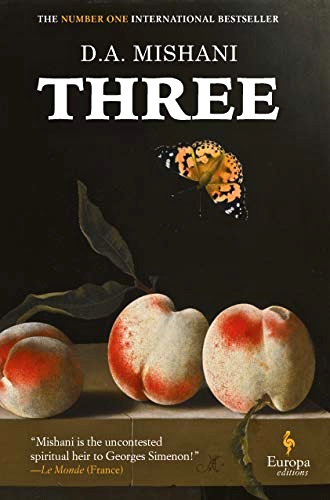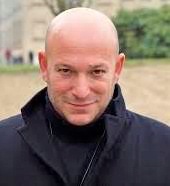“They met on a dating site for divorced singles. His profile was unexciting, which was exactly why she wrote to him. Forty-two years old, divorced once, lives in a Tel Aviv suburb. Not ‘excited to swallow life whole’ or ‘on a self-discovery journey I’d like you to join me on….’ Three pictures…all of which showed something reassuring about his face, nothing too special.”
 Winner of three European prizes for his award-winning detective series featuring police inspector Avraham Avraham, D. A. Mishani changes gears here with this standalone novel. Though he employs all his talents and experience as a detective story writer here in pacing his story and its complications, his primary focus is on the psychology of three women seeking companionship from a man who is looking for a change of scenery without serious commitment. Divided into three parts, the entire first part concerns Orna, the recently divorced mother of a sensitive young son who is receiving therapy for his difficulties in adjusting to the family’s new lives. His father has quickly remarried a woman with two children and has moved with them to Nepal while Orna and her son remain in Tel Aviv.
Winner of three European prizes for his award-winning detective series featuring police inspector Avraham Avraham, D. A. Mishani changes gears here with this standalone novel. Though he employs all his talents and experience as a detective story writer here in pacing his story and its complications, his primary focus is on the psychology of three women seeking companionship from a man who is looking for a change of scenery without serious commitment. Divided into three parts, the entire first part concerns Orna, the recently divorced mother of a sensitive young son who is receiving therapy for his difficulties in adjusting to the family’s new lives. His father has quickly remarried a woman with two children and has moved with them to Nepal while Orna and her son remain in Tel Aviv.

Ancient St. Andrews, now a Scottish guesthouse in Jerusalem, to which one of the women is invited by her lover.
Son Eran has not seen his father, received a note, or had a phone call from him in months, and Orna has been trying to help her boy while working full-time as a teacher and adjusting to her own changed life and expectations after the divorce. When she meets a divorced man on a dating website, she is careful to avoid giving much personal information or assuming an instant connection with him, and he, too, is being careful. Both parties withhold information and hide it behind general statements instead of being open and honest as they conduct their affair. It is not until the hundred-page mark that real action takes place and Mishani’s fame as a mystery writer begins to become obvious as the narrative becomes more plot-based.
Part II introduces Emilia, another young woman, this one an immigrant from Latvia. She has been living as a caretaker for an elderly pediatrician and working with his more agile wife for two years, and when the old man dies, Emilia is out of a job. Seeking part-time work with another elderly woman, she gets the job but has no place to live, little money for food, and major financial problems. When Adina, her elderly charge, goes to a nursing home, Emilia begins to see ghosts and seeks solace in a local church, where the priest feels like her son. Part III introduces a new point of view, that of Ella, the third young woman, one with a family who is trying to complete a thesis for a belated Master’s degree. Ella, like Orna and Emilia, also keeps her life hidden, even when a man tries to befriend her at the cafe where she spends much time working on her research papers. Unlike her predecessors, however, Ella has a secret agenda which makes her much less vulnerable.
To avoid spoilers, I have deliberately omitted key elements which turn this psychological study of three women into a dramatic action novel which speeds along as it absorbs elements from all the preceding sections and combines them into a carefully constructed and un-put-downable mystery novel. Elements of foreshadowing, which most readers will recognize and question as they are reading the stories of the three women, suggest further action and perhaps overlaps during the early stages, and as the novel progresses, filled with “ah-ha” moments, even names begin to repeat. Some characters appear in more than one section, and time speeds up in the final section with important scenes taking place years after the major events which took place in Parts I and II. The book, though different from what it appears to be, at first, is an exciting crime story with well-developed characters, several climactic scenes related to individual women, and a more-than satisfying conclusion. * * *
 Note: My understanding of this novel became clearer with a sudden, accidental discovery. The advance review copy which I received, and the finished copy which has been published in the meantime, both include a quotation from Israel’s Haaretz Book Review on the cover, indicating that this novel “will be remembered as a work that heralded a new-wave in Israeli fiction just as My Michael, by Amos Oz once did.”
Note: My understanding of this novel became clearer with a sudden, accidental discovery. The advance review copy which I received, and the finished copy which has been published in the meantime, both include a quotation from Israel’s Haaretz Book Review on the cover, indicating that this novel “will be remembered as a work that heralded a new-wave in Israeli fiction just as My Michael, by Amos Oz once did.”
Though I have liked and reviewed My Michael, I did not understand what “new-wave” was being heralded here and was curious about it. On the haaretz.com site, I found a most revealing interview between Ayelett Shani and author Dror Mishani, in which the two discuss why “crime novels don’t do so well” in Israel. In short, Mishani says, Israeli literature has traditionally focused on elements of national identity, not on the personal identities of citizens, especially miscreants, who challenge public values, morality, and national goals.
In addition, police are not traditionally celebrated in Israeli novels, and the western cliché of the sad and lonely detective who drowns his sorrows in alcohol does not exist in Israel. In Three the police do not appear until near the ending of the novel, and little time is spent on the development of a case against the criminal because the reader has known the who and why of each crime from the outset. The imaginary back and forth between reader and author common to western crime novels, as the reader tests his/her own thoughts of the crime against what the police believe and discover in the novel, does not occur here, nor is it needed. Readers interested in the history of Israeli crime fiction, will find this interview both entertaining and revelatory, especially in relation to this unusual and intriguing novel.
Photos. Ancient St. Andrews, now a Scottish guesthouse in Jerusalem, may be found on https://www.itraveljerusalem.com
The Hotel Trianon in Bucharest, to which one woman was invited is from https://www.travelagewest.com
Yarkon Park in Tel Aviv is a favorite bike-riding spot for one man. https://www.lonelyplanet.com/
The interview of Dror Mishani by Ayelett Shani appears here on Haaretz: https://www.haaretz.com
My Michael, reviewed in January, 2012, may be found here: http://marywhipplereviews.com
The author’s photo is on https://www.vjbooks.com



